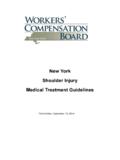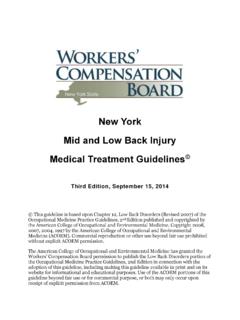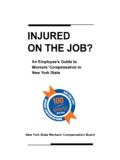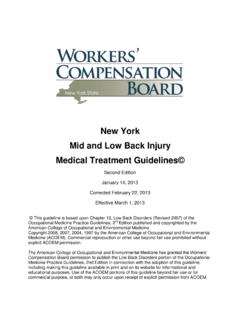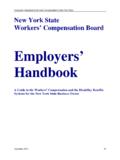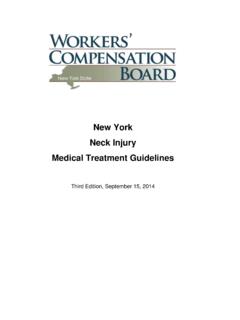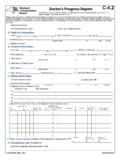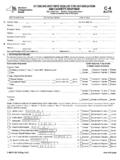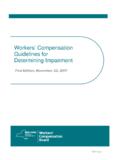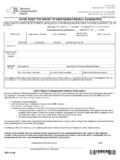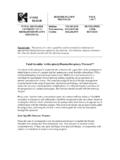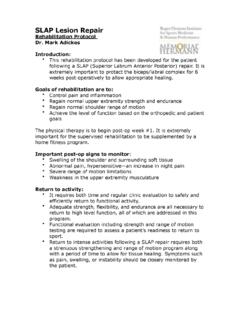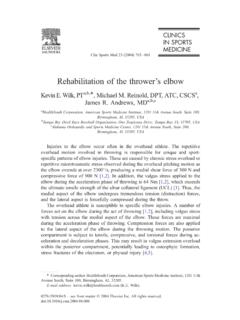Transcription of New York Shoulder Injury Medical Treatment …
1 New york Shoulder Injury Medical Treatment guidelines . Second Edition January 14, 2013. Effective March 1, 2013. Copyright 2008, 2007, 2004, 1997 by the American College of Occupational and Environmental Medicine (ACOEM). Commercial reproduction or other use beyond fair use prohibited without explicit ACOEM permission. New york State Workers' Compensation Board New york Shoulder Injury Medical Treatment guidelines TABLE OF CONTENTS. A GENERAL GUIDELINE PRINCIPLES .. 1. Medical CARE .. 1. RENDERING OF Medical SERVICES .. 1. POSITIVE PATIENT RESPONSE .. 1. RE-EVALUATE Treatment .. 1. EDUCATION .. 2. DIAGNOSTIC TIME FRAMES .. 2. Treatment TIME FRAMES .. 2. SIX-MONTH TIME FRAME .. 2. DELAYED RECOVERY .. 2. ACTIVE 3. ACTIVE THERAPEUTIC EXERCISE PROGRAM .. 3. DIAGNOSTIC IMAGING AND TESTING PROCEDURES .. 3. SURGICAL INTERVENTIONS .. 4. 4. PERSONALITY/PSYCHOLOGICAL/PSYCHOSOCIAL EVALUATIONS .. 4. PERSONALITY/PSYCHOLOGICAL/PSYCHOSOCIAL INTERVENTION.
2 5. FUNCTIONAL CAPACITY EVALUATION (FCE) .. 5. RETURN TO WORK .. 6. JOB SITE EVALUATION .. 6. GUIDELINE RECOMMENDATIONS AND Medical EVIDENCE .. 7. EXPERIMENTAL Treatment .. 7. Second Edition, January 14, 2013 i INJURED WORKERS AS PATIENTS .. 7. SCOPE OF PRACTICE .. 7. B INTRODUCTION TO Shoulder Injury .. 8. C HISTORY TAKING AND PHYSICAL EXAMINATION .. 10. HISTORY TAKING .. 10. PHYSICAL FINDINGS .. 10. RED FLAGS .. 10. FOLLOW-UP DIAGNOSTIC 11. D SPECIFIC DIAGNOSES, TESTING AND Treatment PROCEDURES .. 11. ACROMIOCLAVICULAR (AC) JOINT SPRAINS/DISLOCATIONS .. 11. History and Mechanism of Injury (AC Joint Sprains/ Dislocations) .. 12. Physical Findings (AC Joint Sprains/Dislocations) .. 13. Laboratory Tests (AC Joint Sprains/Dislocations) .. 13. Testing Procedures (AC Joint Sprains/Dislocations) .. 13. Non-Operative Treatment Procedures (AC Joint Sprains/Dislocations) .. 13. Operative Procedures (AC Joint Sprains/Dislocations) .. 14.
3 Post-Operative Procedures (AC Joint Sprains/Dislocations) .. 14. ADHESIVE CAPSULITIS/FROZEN Shoulder DISORDER .. 15. History and Mechanism of Injury (Adhesive Capsulitis/Frozen Shoulder ) 15. Physical Findings (Adhesive Capsulitis/Frozen Shoulder ) .. 15. Laboratory Tests (Adhesive Capsulitis/Frozen Shoulder ) .. 16. Testing Procedures (Adhesive Capsulitis/Frozen Shoulder ) .. 16. Non-Operative Treatment Procedures (Adhesive Capsulitis/Frozen Shoulder ) .. 16. Operative Procedures (Adhesive Capsulitis/Frozen Shoulder ) .. 18. Post-Operative Procedures (Adhesive Capsulitis/Frozen Shoulder ) .. 18. Second Edition, January 14, 2013 ii BICIPITAL TENDON DISORDERS .. 18. History and Mechanism of Injury (Bicipital Tendon Disorders) .. 18. Physical Findings (Bicipital Tendon Disorders) .. 19. Laboratory Tests (Bicipital Tendon Disorders) .. 20. Testing Procedures (Bicipital Tendon Disorders) .. 20. Non-Operative Treatment Procedures (Bicipital Tendon Disorders).
4 20. Operative Procedures (Bicipital Tendon Disorders) .. 21. Post-Operative Procedures (Bicipital Tendon Disorders) .. 22. BRACHIOPLEXUS INJURIES .. 22. Brachial Plexus .. 23. Axillary Nerve .. 24. Long Thoracic 26. Musculocutaneous Nerve .. 27. Spinal Accessory 29. Suprascapular Nerve .. 30. BURSITIS OF THE Shoulder .. 32. History and Mechanism of Injury (Bursitis of the Shoulder ) .. 32. Physical Findings (Bursitis of the Shoulder ) .. 32. Laboratory Tests (Bursitis of the Shoulder ) .. 32. Testing Procedures (Bursitis of the Shoulder ) .. 33. Non-Operative Treatment Procedures (Bursitis of the Shoulder ).. 33. Operative Procedures (Bursitis of the Shoulder ) .. 33. IMPINGEMENT SYNDROME .. 34. History and Mechanism of Injury (Impingement Syndrome) .. 34. Physical Findings (Impingement Syndrome) .. 35. Second Edition, January 14, 2013 iii Laboratory Tests (Impingement Syndrome) .. 35. Testing Procedures (Impingement Syndrome) .. 35.
5 Non-Operative Treatment Procedures (Impingement Syndrome) .. 36. Operative Procedures (Impingement Syndrome) .. 37. Post-Operative Procedures (Impingement Syndrome) .. 38. ROTATOR CUFF 38. History and Mechanism of Injury (Rotator Cuff Tear) .. 38. Physical Findings (Rotator Cuff Tear) .. 39. Laboratory Tests (Rotator Cuff Tear) .. 39. Testing Procedures (Rotator Cuff Tear) .. 40. Non-Operative Treatment Procedures (Rotator Cuff Tear) .. 40. Operative Procedures (Rotator Cuff Tear) .. 41. Post-Operative Procedures (Rotator Cuff Tear).. 43. ROTATOR CUFF 44. History and Mechanism of Injury (Rotator Cuff Tendinitis) .. 44. Physical Findings (Rotator Cuff Tendinitis) .. 44. Laboratory Tests (Rotator Cuff Tendinitis) .. 44. Testing Procedures (Rotator Cuff Tendinitis) .. 44. Non-Operative Treatment Procedures (Rotator Cuff Tendinitis) .. 45. Operative Procedures (Rotator Cuff Tendinitis) .. 45. Shoulder FRACTURES .. 45. Clavicular Fracture.
6 45. Proximal Humeral Fracture .. 47. Humeral Shaft Fracture .. 50. Scapular Fracture .. 52. Second Edition, January 14, 2013 iv Sternoclavicular Dislocation/Fracture .. 54. Shoulder INSTABILITY .. 55. History and Mechanism of Injury ( Shoulder Instability) .. 55. Physical Findings ( Shoulder Instability).. 56. Laboratory Tests ( Shoulder Instability) .. 57. Testing Procedures ( Shoulder Instability) .. 57. Non-Operative Treatment Procedures ( Shoulder Instability) .. 57. Operative Procedures ( Shoulder Instability) .. 58. Post-Operative Procedures ( Shoulder Instability) .. 58. SUPERIOR LABRUM ANTERIOR AND POSTERIOR (SLAP) LESIONS .. 59. History and Mechanisms of Injury (SLAP lesion) .. 59. Physical Findings (SLAP lesion) .. 60. Diagnostic Testing Procedures (SLAP lesion).. 61. Non-Operative Treatment Procedures (SLAP Lesion) .. 61. Surgical Indications .. 62. Operative Procedures (SLAP lesion) .. 63. Post-Operative Treatment (SLAP lesion).
7 64. E THERAPEUTIC PROCEDURES: 64. MEDICATIONS .. 64. 64. Hypnotics .. 65. Narcotics .. 65. Nonsteroidal Anti-Inflammatory Drugs (NSAIDs) .. 66. Psychotropic/Anti-Anxiety Medications .. 68. Skeletal Muscle 68. Second Edition, January 14, 2013 v Topical Drug 68. Tramadol .. 69. IMMOBILIZATION .. 69. Kinesiotaping, Taping or Strapping .. 70. RELATIVE REST .. 70. THERAPEUTIC EXERCISE .. 70. SUPERFICIAL HEAT AND COLD .. 70. TRANSCUTANEOUS ELECTRICAL NERVE STIMULATION (TENS) ..71. THERAPEUTIC ULTRASOUND WITH OR WITHOUT ELECTRIC. ELECTRICAL THERAPEUTIC MODALITY .. 72. RETURN TO WORK .. 72. BIOFEEDBACK .. 72. PHYSICAL MEDICINE AND REHABILITATION .. 72. Instruction in Therapeutic Exercise and Proper Work Techniques .. 72. Manual Therapy Techniques .. 73. Post-Operative Treatment .. 73. THERAPY: ONGOING MAINTENANCE CARE .. 73. Index .. 76. Second Edition, January 14, 2013 vi New york State Workers' Compensation Board New york Shoulder Injury Medical Treatment guidelines A GENERAL GUIDELINE PRINCIPLES.
8 The principles summarized in this section are key to the intended application of the New york State Medical Treatment guidelines . Medical Care Medical CARE. Medical care and Treatment required as a result of a work-related Injury should be focused on restoring functional ability required to meet the patient's daily and work activities and return to work, while striving to restore the patient's health to its pre- Injury status in so far as is feasible. RENDERING OF Medical SERVICES. Any Medical provider rendering services to a workers compensation patient must utilize the Treatment guidelines as provided for with respect to all work-related injuries and or illnesses. POSITIVE PATIENT RESPONSE. Positive results are defined primarily as functional gains which can be objectively measured. Objective functional gains include, but are not limited to, positional tolerances, range of motion, strength, endurance, activities of daily living, cognition, psychological behavior, and efficiency/velocity measures which can be quantified.
9 Subjective reports of pain and function should be considered and given relative weight when the pain has anatomic and physiologic correlation. RE-EVALUATE Treatment . If a given Treatment or modality is not producing positive results, the provider should either modify or discontinue the Treatment regime. The provider should evaluate the efficacy of the Treatment or modality 2 to 3. weeks after the initial visit and 3 to 4 weeks thereafter. Reconsideration of diagnosis should also occur in the event of poor response to a rational intervention. Second Edition, January 14, 2013 1. Education EDUCATION. Education of the patient and family, as well as the employer, insurer, policy makers and the community should be a primary emphasis in the Treatment of work-related Injury or illness. Practitioners must develop and implement effective educational strategies and skills. An education- based paradigm should always start with communication providing reassuring information to the patient.
10 No Treatment plan is complete without addressing issues of individual and/or group patient education as a means of facilitating self-management of symptoms and prevention of future Injury . Time Frames DIAGNOSTIC TIME FRAMES. Diagnostic time frames for conducting diagnostic testing commence on the date of Injury . Clinical judgment may substantiate the need to accelerate or decelerate the time frames discussed in this document. Treatment TIME FRAMES. Treatment time frames for specific interventions commence once treatments have been initiated, not on the date of Injury . Obviously, duration may be impacted by disease process and severity, patient compliance, as well as availability of services. Clinical judgment may substantiate the need to accelerate or decelerate the time frames discussed in this document. SIX-MONTH TIME FRAME. Since the prognosis drops precipitously for returning an injured worker to work once he/she has been temporarily totally disabled for more than six months, the emphasis within these guidelines is to move patients along a continuum of care and return to work within a six-month time frame, whenever possible.
